Inspect connector connection, and check terminal for poor connections, loose wires, bent, broken or corroded pins, and then verify that the connectors are always securely fastened.
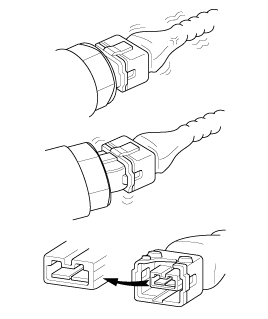
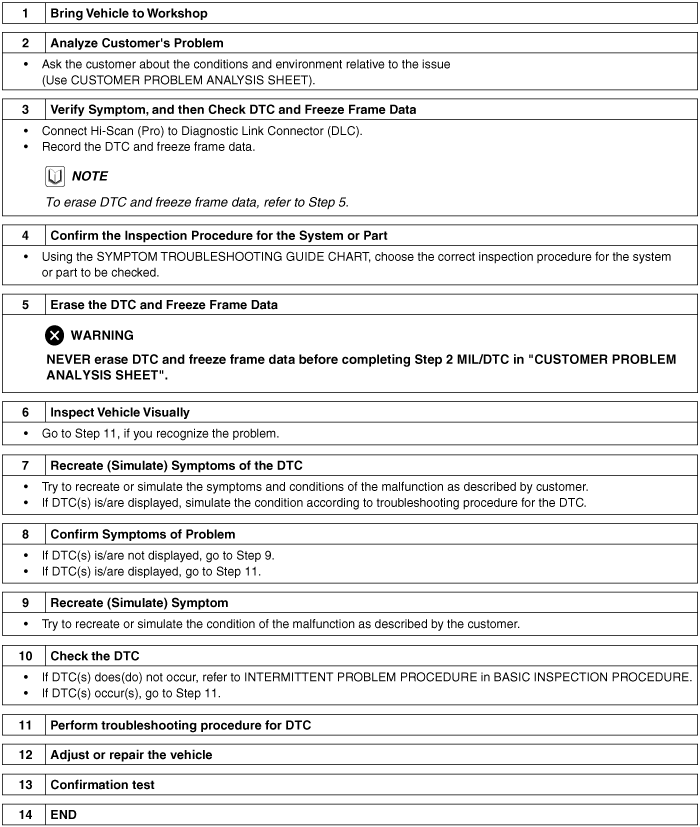
VEHICLE INFORMATION
(I) VIN: |
(II) Production Date: |
(III) Odometer Reading: (miles) |
SYMPTOMS
□ Unable to start | □ Engine does not turn over □ Incomplete combustion □ Initial combustion does not occur |
□ Difficult to start | □ Engine turns over slowly □ Other_________________ |
□ Poor idling | □ Rough idling □ Incorrect idling □ Unstable idling (High: ______ rpm, Low: ______rpm) □ Other __________________________________ |
□ Engine stall | □ Soon after starting □ After accelerator pedal depressed □ After accelerator pedal released □ During A/C ON □ Shifting from N to D-range □ Other _______________________________________________ |
□ Others | □ Poor driving (Surge) □ Knocking □ Poor fuel economy □ Back fire □ After fire □ Other ____________________________ |
ENVIRONMENT
Problem frequency | □ Constant □ Sometimes (_________________) □ Once only □ Other ___________________________________________ |
Weather | □ Fine □ Cloudy □ Rainy □ Snowy □ Other __________________ |
Outdoor temperature | Approx. _____ °C/°F |
Place | □ Highway □ Suburbs □ Inner City □ Uphill □ Downhill □ Rough road □ Other ___________________________________ |
Engine temperature | □ Cold □ Warming up □ After warming up □ Any temperature |
Engine operation | □ Starting □ Just after starting (____ min) □ Idling □ Racing □ Driving □ Constant speed □ Acceleration □ Deceleration □ A/C switch ON/OFF □ Other _____________________________ |
MIL/DTC
MIL (Malfunction Indicator Lamp) | □ Remains ON □ Sometimes lights up □ Does not light |
DTC | □ Normal □ DTC (_______________________________________) □ Freeze Frame Data |
The measured resistance at high temperature after vehicle running may be high or low. So all resistance must be measured at ambient temperature (20℃, 68℉), unless there is any notice.
The measured resistance in except for ambient temperature (20℃, 68℉) is reference value.
Sometimes the most difficult case in troubleshooting is when a problem symptom occurs but does not occur again during testing. An example would be if a problem appears only when the vehicle is cold but has not appeared when warm. In this case, the technician should thoroughly make out a "CUSTOMER PROBLEM ANALYSIS SHEET" and recreate (simulate) the environment and condition which occurred when the vehicle was having the issue.
Clear Diagnostic Trouble Code (DTC).
Inspect connector connection, and check terminal for poor connections, loose wires, bent, broken or corroded pins, and then verify that the connectors are always securely fastened.

Slightly shake the connector and wiring harness vertically and horizontally.
Repair or replace the component that has a problem.
Verify that the problem has disappeared with the road test.
● SIMULATING VIBRATION
Sensors and Actuators
: Slightly vibrate sensors, actuators or relays with finger.
Strong vibration may break sensors, actuators or relays
Connectors and Harness
: Lightly shake the connector and wiring harness vertically and then horizontally.
● SIMULATING HEAT
Heat components suspected of causing the malfunction with a hair dryer or other heat sourre.
DO NOT heat components to the point where they may be damaged.
DO NOT heat the ECM/PCM directly.
● SIMULATING WATER SPRINKLING
Sprinkle water onto vehicle to simulate a rainy day or a high humidity condition.
DO NOT sprinkle water directly into the engine compartment or electronic components.
● SIMULATING ELECTRICAL LOAD
Turn on all electrical systems to simulate excessive electrical loads (Radios, fans, lights, etc.).
Handling of Connector
Never pull on the wiring harness when disconnecting connectors.

When removing the connector with a lock, press or pull locking lever.

Listen for a click when locking connectors. This sound indicates that they are securely locked.

When a tester is used to check for continuity, or to measure voltage, always insert tester probe from wire harness side.
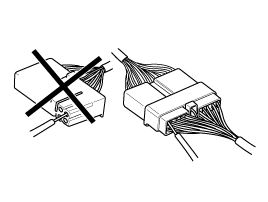
Check waterproof connector terminals from the connector side. Waterproof connectors cannot be accessed from harness side.
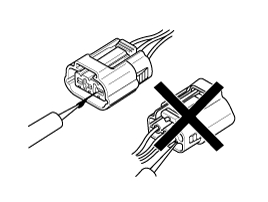
Use a fine wire to prevent damage to the terminal.
Do not damage the terminal when inserting the tester lead.
Checking Point for Connector
While the connector is connected:
Hold the connector, check connecting condition and locking efficiency.
When the connector is disconnected:
Check for missing terminal, crimped terminal or broken core wire by slightly pulling the wire harness.
Visually check for rust, contamination, deformation and bend.
Check terminal tightening condition:
Insert a spare male terminal into a female terminal, and then check terminal tightening conditions.
Pull lightly on individual wires to ensure that each wire is secured in the terminal.
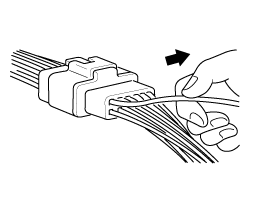
Repair Method of Connector Terminal
Clean the contact points using air gun and/or shop rag.
Never use sand paper when polishing the contact points, otherwise the contact point may be damaged.
In case of abnormal contact pressure, replace the female terminal.
Before removing the wire harness, check the wire harness position and crimping in order to restore it correctly.
Check whether the wire harness is twisted, pulled or loosened.
Check whether the temperature of the wire harness is abnormally high.
Check whether the wire harness is rotating, moving or vibrating against the sharp edge of a part.
Check the connection between the wire harness and any installed part.
If the covering of wire harness is damaged; secure, repair or replace the harness.
Procedures for Open Circuit
Continuity Check
Voltage Check
If an open circuit occurs (as seen in [FIG. 1]), it can be found by performing Step 2 (Continuity Check Method) or Step 3 (Voltage Check Method) as shown below.
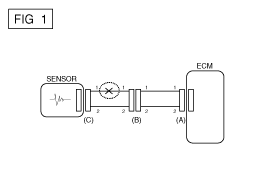
Continuity Check Method
When measuring for resistance, lightly shake the wire harness above and below or from side to side.
Specification (Resistance)
1Ω or less → Normal Circuit
1㏁ or Higher → Open Circuit
Disconnect connectors (A), (C) and measure resistance between connector (A) and (C) as shown in [FIG. 2].
In [FIG.2.] the measured resistance of line 1 and 2 is higher than 1㏁ and below 1 Ω respectively. Specifically the open circuit is line 1 (Line 2 is normal). To find exact break point, check sub line of line 1 as described in next step.
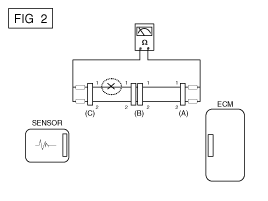
Disconnect connector (B), and measure for resistance between connector (C) and (B1) and between (B2) and (A) as shown in [FIG. 3].
In this case the measured resistance between connector (C) and (B1) is higher than 1㏁ and the open circuit is between terminal 1 of connector (C) and terminal 1 of connector (B1).
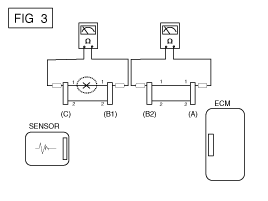
Voltage Check Method
With each connector still connected, measure the voltage between the chassis ground and terminal 1 of each connectors (A), (B) and (C) as shown in [FIG. 4].
The measured voltage of each connector is 5V, 5V and 0V respectively. So the open circuit is between connector (C) and (B).

Test Method for Short to Ground Circuit
Continuity Check with Chassis Ground
If short to ground circuit occurs as shown in [FIG. 5], the broken point can be found by performing below Step 2 (Continuity Check Method with Chassis Ground) as shown below.
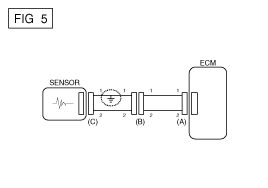
Continuity Check Method (with Chassis Ground)
Lightly shake the wire harness above and below, or from side to side when measuring the resistance.
Specification (Resistance)
1Ω or less → Short to Ground Circuit
1MΩ or Higher → Normal Circuit
Disconnect connectors (A), (C) and measure for resistance between connector (A) and Chassis Ground as shown in [FIG. 6].
The measured resistance of line 1 and 2 in this example is below 1 Ω and higher than 1MΩ respectively. Specifically the short to ground circuit is line 1 (Line 2 is normal). To find exact broken point, check the sub line of line 1 as described in the following step.
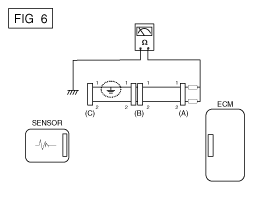
Disconnect connector (B), and measure the resistance between connector (A) and chassis ground, and between (B1) and chassis ground as shown in [FIG. 7].
The measured resistance between connector (B1) and chassis ground is 1Ω or less. The short to ground circuit is between terminal 1 of connector (C) and terminal 1 of connector (B1).

MAIN SYMPTOM | DIAGNOSTIC PROCEDURE | ALSO CHECK FOR | |
Unable to start (Engine does not turn over) | 1. Test the battery 2. Test the starter 3. Inhibitor switch (A/T) or clutch start switch (M/T) | ||
Unable to start (Incomplete combustion) | 1. Test the battery 2. Check the fuel pressure 3. Check the ignition circuit 4. Troubleshooting the immobilizer system (In case of immobilizer lamp ON) | ● DTC ● Low compression ● Intake air leaks ● Slipped or broken timing belt ● Contaminated fuel | |
Difficult to start | 1. Test the battery 2. Check the fuel pressure 3. Check the ECT sensor and circuit (Check DTC) 4. Check the ignition circuit | ● DTC ● Low compression ● Intake air leaks ● Contaminated fuel ● Weak ignition spark | |
Poor idling (Rough, unstable or incorrect Idle) | 1. Check the fuel pressure 2. Check the Injector 3. Check the long term fuel trim and short term fuel trim (Refer to CUSTOMER DATASTREAM) 4. Check the idle speed control circuit (Check DTC) 5. Inspect and test the Throttle Body 6. Check the ECT sensor and circuit (Check DTC) | ● DTC ● Low compression ● Intake air leaks ● Contaminated fuel ● Weak ignition spark | |
Engine stall | 1. Test the Battery 2. Check the fuel pressure 3. Check the idle speed control circuit (Check DTC) 4. Check the ignition circuit 5. Check the CKPS Circuit (Check DTC) | ● DTC ● Intake air leaks ● Contaminated fuel ● Weak ignition spark | |
Poor driving (Surge) | 1. Check the fuel pressure 2. Inspect and test Throttle Body 3. Check the ignition circuit 4. Check the ECT Sensor and Circuit (Check DTC) 5. Test the exhaust system for a possible restriction 6. Check the long term fuel trim and short term fuel trim (Refer to CUSTOMER DATASTREAM) | ● DTC ● Low compression ● Intake air leaks ● Contaminated fuel ● Weak ignition spark | |
Knocking | 1. Check the fuel pressure 2. Inspect the engine coolant 3. Inspect the radiator and the electric cooling fan 4. Check the spark plugs | ● DTC ● Contaminated fuel | |
Poor fuel economy | 1. Check customer's driving habits
2. Check the fuel pressure 3. Check the injector 4. Test the exhaust system for a possible restriction 5. Check the ECT sensor and circuit | ● DTC ● Low compression ● Intake air leaks ● Contaminated fuel ● Weak ignition spark | |
Hard to refuel (Overflow during refueling) | 1. Test the canister close valve 2. Inspect the fuel filler hose/pipe
3. Inspect the fuel tank vapor vent hose between the EVAP. canister and air filter 4. Check the EVAP. canister | ● Malfunctioning gas station filling nozzle (If this problem occurs at a specific gas station during refueling) |